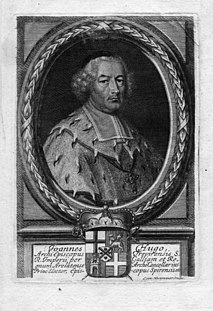
William V, called the Pious, was Duke of Bavaria from 1579 to 1597.

Lothar Franz von Schönborn-Buchheim was the Archbishop-Elector of Mainz from 1694 to 1729 and the Bishop of Bamberg from 1693 to 1729. As Archbishop of Mainz, he was also Archchancellor of the Holy Roman Empire. Lothar Franz von Schönborn is known for commissioning a number of Baroque buildings, such as the palace Schloss Weissenstein.

Anne of Bohemia and Austria was a Duchess of Luxembourg in her own right and, as a consort, Landgravine of Thuringia and of Saxony.

Ernest of Bavaria was Prince-elector-archbishop of the Archbishopric of Cologne from 1583 to 1612 as successor of the expelled Gebhard Truchsess von Waldburg. He was also bishop of Münster, Hildesheim, Freising and Liège.
Folmar of Karden, also occurring in the variant forms Fulmar, Vollmar, Formal, or Formator, was the Archbishop of Trier from 1183 and the last not also to be a prince elector. He opposed the emperor in the late twelfth-century phase of the Investiture Controversy. The historian Bernhard von Simson characterized Folmar as "that restless, ambitious, and hard-hearted man."

von der Leyen is an ancient German noble family of princely and historically sovereign rank. As a former ruling and mediatized family, it belongs to the Hochadel.

Augustus of Saxe-Weissenfels, was a Duke of Saxe-Weissenfels-Querfurt of the House of Wettin and administrator of the Archbishopric of Magdeburg.

John Casimir, Count Palatine of Zweibrücken-Kleeburg was the son of John I, Count Palatine of Zweibrücken and his wife, Duchess Magdalene of Jülich-Cleves-Berg and was the founder of a branch of Wittelsbach Counts Palatine often called the Swedish line, because it gave rise to three subsequent kings of Sweden, but more commonly known as the Kleeburg line.

Frederick II of Hesse-Homburg, also known as the Prince of Homburg was Landgrave of Hesse-Homburg. He was also a successful and experienced general for the crowns of both Sweden and of Brandenburg, but is best remembered as the eponymous hero of Heinrich von Kleist's play Der Prinz von Homburg.

Ottilie of Katzenelnbogen, was by marriage Margravine of Baden-Baden.

Damian Hartard Reichsfreiherr von der Leyen-Hohengeroldseck was the Archbishop-Elector of Mainz and the Bishop of Worms from 1675 to 1678.

Johann Hugo von Orsbeck (1634–1711) was the Archbishop-Elector of Trier from 1675 to 1711.
Maria Clara Eimmart, was a German astronomer, engraver and designer. She was the daughter and assistant of Georg Christoph Eimmart the Younger.
John II of Baden was a titular Margrave of Baden and was Archbishop and Elector of Trier as John II of Baden from 1456 until his death in 1503.

The Elector of Trier was one of the Prince-Electors of the Holy Roman Empire and, in his capacity as archbishop, administered the archdiocese of Trier. The territories of the electorate and the archdiocese were not, however, equivalent.

Arnold I of Vaucourt, was the Archbishop of Trier from 1169 to 1183. He took a pro-Imperial position in the Investiture Controversy of the twelfth century. As archbishop, Arnold was accounted a capable ruler, by turns thrifty and generous, with a genuine concern for his church and his domain.
Ruotger, also spelled Rutger, Rudger or Rudgar, was the archbishop of Trier from 915. His archdiocese at first lay within the kingdom of West Francia, but after 925 it was annexed to East Francia, an event in which Ruotger played a major role.
The imperial election of 1658 was an imperial election held to select the emperor of the Holy Roman Empire. It took place in Frankfurt on July 18.
























